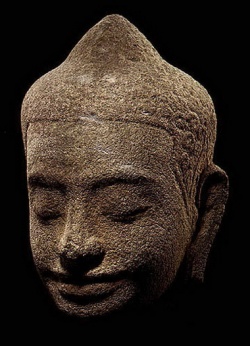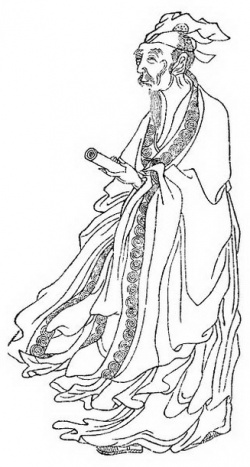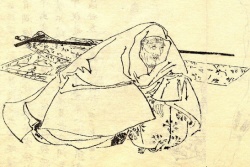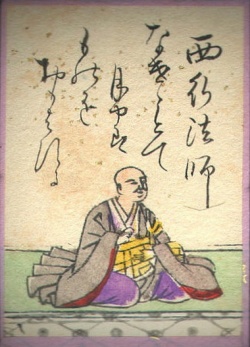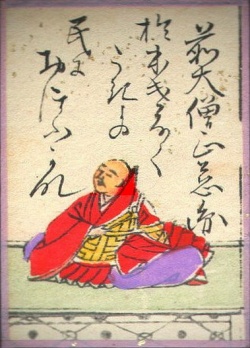Buddhist poetry
Buddhist poetry is a genre of literature that forms a part of Buddhist discourse. The first examples of Buddhist poetry can be found in traditional scriptures such as the Dhammapada, according to which, Siddhārtha Gautama (the founder of Buddhism), upon his reaching Enlightenment, proclaimed:
Through the round of many births I roamed
without reward,
without rest,
seeking the house-builder.
Painful is birth
again & again.
House-builder, you're seen!
You will not build a house again.
All your rafters broken,
the ridge pole destroyed,
gone to the Unformed, the mind
has come to the end of Craving.
Traditionally, most Buddhist sutras have a prose component supplemented by verses (known as gatha) that reiterate and poetically summarize the themes of preceding prose passages. Gatha functions as a mnemonic device helping the Buddhist practitioner commit to memory a certain doctrinal maxim. And in fact, the earliest extant forms of Buddhist discourse appear in verse, which is hardly surprising, considering that the texts were not originally written, but memorized. Linguistic analysis shows that the prose component of the sutras is likely to have been modified by later editing, while the poems often contain earlier forms of Language. This view is confirmed by Japanese Buddhist scholar Hajime Nakamura, who states that the verse components of the Pali Canon actually predate the prose components, the former being a way of facilitating memorization, as the Pali Canon was transmitted orally for the first 300 or so years.
Current Buddhology generally maintains that even the liturgical scriptures are products of literary composition. Hence, the study of Buddhist text in general and Buddhist poetry in particular cannot be disengaged from the literary field. But for the sake of classification it is useful to distinguish between
Buddhist poetry that is attributed to The Buddha himself, which forms a part of "Buddha Speech" (Sk. Buddhavacana), and
Buddhist poetry written by Buddhists, which is not included in the sutras.
This article concerns primarily with the latter.
Buddhist poetry in Asia
A typical example of a Buddhist poet is Monk Aśvaghoṣa who used his poetic talent and education in Brahmanic tradition to compose poetry on various Buddhist themes, e.g. the Life of The Buddha, the Buddhacarita.
Buddhist poetry – like the bulk of the scriptures produced by Buddhists – is not limited to compositions in Pali and Sanskrit; it has flourished in practically every Language that Buddhists speak.
Notable examples in the Tibetan tradition are works of Milarepa.
Chinese Buddhist Tradition is particularly rich in poetic expression, e.g. Buddhist poems of Bai Juyi are quite famous. In Bai Juyi's poetry we see a tension between the secular and Buddhist poetic expression: many Buddhists considered poetry as an attachment and advocated against it, despite the fact that the scriptures revered by them were abundant in poetic forms. He is credited with the coinage of the expression kyōgen kigo (狂言綺語, lit. "deranged words and embellished Language"), which, to his view, referred to futility of poetic expression in comparison to Buddhist practice. Perhaps, the most successful Chinese Buddhist poet to resolve this paradox was Jiao Ran 皎然 (730-799), who proposed treatment of poetry as an intellectual instrument of Buddhist practice.
Korean poets wrote mostly in Classical Chinese.
Japanese poets also contributed to Buddhist poetic tradition in classical Chinese (e.g. the poetic genius of Kūkai inspired many poets of later generations.) Kūkai, in turn was influenced by Jiao Ran's Shi shi 詩式, as the latter is included in Kūkai's magnum opus of poetics, the Bunkyō hifuron 文鏡秘府論.
In medieval Japan, Buddhist poetry was accorded a special status of a separate genre within the corpus of the waka collections.
Japanese Buddhist Poetry
1. The earliest extant collection of the Japanese poetry, the Man'yōshū, contains a preface (Jp. jo 序 or daishi 題詞) to two poems on the Love of parents towards their children: "Sakyamuni expounds truthfully from his golden mouth, 'I Love all things equally, the way I Love my child, Rahula.' He also teaches that 'no Love is greater than the Love for ones child.' Even the greatest of saints cherishes his child. Who, then, among the living creatures of this world could fail to Love children claimed as one's own" There are several prefaces and poems in the Man'yōshū that mention the name of Buddha Śākyamuni (Jp. Shaka Nyorai 釋迦如来 /an honorific title of Siddhārtha Gautama), Buddhist temples (Jp. tera 寺), monks and nuns.
2. Among the treasures of Yakushi-ji Temple in Nara there are stone blocks dating from the Nara period modeled as "the footsteps" of The Buddha (Jp. Bussokuseki 佛足石). These blocks contain poems in man'yōgana that may be considered the oldest Buddhist waka (Japanese Language poems) known to date. These poems are usually referred to as bussokusekika (lit. "poems on stone imprints of Buddha's feet": 仏足石歌). Consider the following example:
Both examples above have one trait in common. Namely, the focus on the physical characteristics of The Buddha is prominent: "the golden mouth" of The Buddha in the Man'yoshu and the "feet of The Buddha" in the stone inscriptions relate to the marks of perfection of The Buddha's Body / speech (Skt. mahāpuruṣa, lit. [signs of] "a great person").
In the Heian period, Buddhist poetry began to be anthologized in the Imperial Anthologies (Jp. chokusenshū 勅選集. Among the 21 Imperial Anthologies, 19 contain Buddhist tanka (lit. short waka) starting with the Shūi Wakashū, compiled between 1005 and 1007 C.E.
The first Imperial Anthology to treat Buddhist tanka as a separate genre, i.e. shakkyōka (lit. "Poems of Śākyamuni's Teaching": 釈教歌), is the Senzai Wakashū, which has an exclusive section dedicated to the Buddhist Poems in Volume 19 (第十九巻). Among the most famous poets who wrote shakkyōka are: Saigyō; Jakuren; Kamo no Chōmei; Fujiwara no Shunzei; Jien; Nōin; Dōgen, Ton'a, etc. Many of the so-called "Thirty-six Poetry Immortals" wrote Buddhist poetry.
Shakkyōka can be subdivided according to the ten following motifs:
Buddhas and bodhisattvas;
Eminent monks / nuns;
A passage from a Sutra;
A passage from commentatorial corpus of the Buddhist canon;
Buddhist Experience (meditative / devotional states);
Mental states, such as Delusion, passion, Anger, etc. that are important in the Buddhist discourse;
Religious deeds;
Related to temples and shrines;
Buddhist views of Nature;
Natural phenomena alluding to Buddhist themes (e.g. transience of Flowers blooming)
These motifs are not mutually exclusive and are very often combined within a given poem.
One of the most famous collections of Japanese tanka of the Kamakura period, the Hyakunin Isshu contains several shakkyōka, for instance Poem 95, by Jien (also anthologized in the Senzai Wakashū: 巻十七, 雑中, No. 1137):
おほけなく
うき世の民に
おほふかな
わがたつそまに
墨染の袖
Unworthy though I am,
I cast my black robe of a Monk
Upon this Suffering world,
Living here
On the Mount of Timber.
In later periods, as tanka was slowly being overshadowed by renga and haiku – the two poetic forms that derived from tanka – such famous poets as "the seven worthies of renga", (Jp. renga shichiken 連歌七賢) of the Muromachi period, Sōgi, and still later, Matsuo Bashō, Kobayashi Issa, among many others, carried on the tradition of Buddhist poetry with their compositions.
菊の香や
奈良には古き
仏達
Kiku no ka ya
Nara ni wa furuki
Hotoketachi
In the city of Nara
Fragrance of chrysanthemums;
Buddhas of yore.
Bashō
The nostalgic feeling of the ancient capital, Nara – interspersed with the scent of chrysanthemums (Symbol of Japanese monarchy) and the old Buddha statues – captures well the aesthetic ideals of sabi and yūgen in this famous haiku. Although these three lines appear to be a mere utterance of almost prosaic quality, the imagery invoked is far from simplistic. Buddhas, emperors, passage of time, the ethereal Beauty of Flowers that presents itself obliquely, i.e., appealing to scent rather than sight – all suggest that the poet sought to use Language as a medium of condensed imagery to map an immediate experience, whose richness can only be read in the blanks.
露の世は露の世ながらさりながら
tsuyu no yo wa tsuyu no yo nagara sari nagara
This world of dew
is just a world of dew,
and yet...
Issa
Here the poet uses the image of evanescence of our world, the dewdrop – one of the classical allegories of the Buddhist teaching – to express Grief caused by the Death of his daughter. In theory, Buddhism teaches its followers to regard all the vicissitudes of Life as transitory and ephemeral, akin to magic apparitions without substance or dewdrops soon to evaporate under the sun. Yet, a father's loss of his child is more than reason can counter.
Buddhist poetry and modernity
As Japan reached the era of industrialized modernity, many of the poets of the Meiji period started to experiment with the European styles of poetic composition. Some poets, notably Miyazawa Kenji – a devout Buddhist, who expressed his convictions in his poetry and fiction – often composed poems with Buddhist overtones. His Ame ni mo Makezu (雨ニモマケズ) is known to practically every Japanese today. Miyazawa Kenji revered the Lotus Sutra 妙法蓮華經, which lent its theme to the poem (Chapter 14: Peaceful and Joyous Deeds / Jp. Anrakugyō 安楽行).
A Modern Indian Sanskrit poet, Vanikavi Dr. Manomohan Acharya wrote Sri Gautama Buddha Panchakam in simple and lucid Sanskrit through lyrical style. Ultimately, everyone who learns Japanese today would be familiar with the Iroha poem. Originally written in man'yōgana and attributed to Kūkai, this Buddhist poem contains every kana precisely once, and is learned in Japanese primary schools mainly for this reason. Many old-style Japanese dictionaries adhere to the Iroha order.
